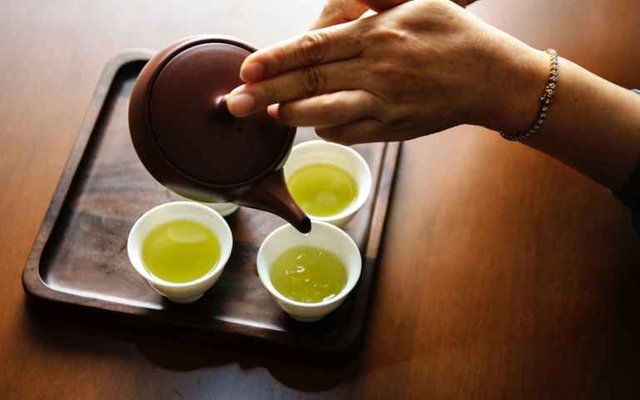PRESERVING TEA: PRESERVING POLYPHENOLS, THEANINE, CAFFEINE AND ASCORBIC ACID

The Tea is a major drink in worldwide.
Considered as a medicinal remedy for several centuries, "tea entered the world of Chinese poetry of the eighth century" and "was ennobled in the fifteenth century by Japan, which elevated to the rank of religion of aesthetics: theism - a worship based on the adoration of beauty in the midst of the sordid facts of everyday life.

Tasting Japanese green tea and mochi.
Several previous studies, for example, explain that EGCG from green tea (the most abundant tea flavanol) could prevent heart attacks, that matcha green tea is good for the skin, that nanoparticles of tea leaves destroy cancer cells of the lung, or that green tea acts on the oral flora and against the cancer of the mouth.
Consume tea is a simple act to do everyday. The purchase of tea, its preparation and its varieties make it an easy drink for the majority of people.
Despite a sometimes high cost for some teas, such as rare Japanese teas (Gyokuro, ...) or specific as matcha green tea (Uji matcha, ...), a good tea is still available. Note that some teas, such as teas of Chinese artisans are out of reach for the common mortal, such as Da Hong Pao, Panda Dung tea, Tieguanyin, or Pu-Erh, which can sometimes be worth up to several hundreds of euros a gram.
In order to enjoy all the benefits of tea, it is important to buy a tea of
quality, to respect certain conditions of conservation and preparation.

Black tea and green tea are good for your health.
TEA, MILE DRINK AND VIRTUES
The tea plant (Camellia sinensis) is an economically important crop. Its leaves and buds are used to produce tea, one of the largest and most widely consumed non-alcoholic beverages in the world.
Data from the United Nations Food and Agriculture Organization (FAO) website indicates that about 2,240,594 ha of land in China was used for tea growing in 2016.
For more than a decade, serious studies have provided green tea with surprising effects, such as helping to prevent obesity, cardiovascular disease and Alzheimer's disease.
A new study published in Nature journal Horticulture Research on October 1, 2018 reveals the effects of temperature on changes in ascorbic acid metabolism in harvested tea leaves.

The art of consuming green tea.
GREEN TEA AND ASCORBIC ACID
Ascorbic acid, called vitamin C, is present in plants and several animal species. Ascorbic acid is an organic compound with antioxidant properties.
In higher vascular plants, ascorbic acid plays a vital role in physiological regulation and may be involved in the response to ozone, pathogen attacks and senescence.
Given these functions, ascorbic acid is an important organic compound in tea plants.
Researchers have shown that ascorbic acid from green tea extracts can inhibit atherogenesis. For example, in rats, ascorbic acid derived from green tea may help protect against the toxic effects of orally ingested arsenic and enhance cellular antioxidant effects.
Abiotic stresses (drought, climatic variations, mineral deficiencies, excessive salinity, ...), including unfavorable temperature conditions, affect the distribution and levels of ascorbic acid in plants.
High and low temperatures induce expression of the ascorbate peroxidase (APX) gene in tea plants. The low temperatures induce the expression of the ascorbate peroxidase 3 (APX3) gene.
In addition, the expression levels of the APX gene are regulated by various abiotic stresses such as salinity, intense light and hydrogen peroxide (H2O2).
In recent years, with the development of the tea industry and the expansion of tea growing areas, traditional tea manufacturers have been replaced by machines.
A large number of tea leaves are needed to meet the ever-increasing demands of the tea industry.
Therefore, storage and transportation of tea leaves have become important concerns in tea production.

Explosion of tea production.
IMPORTANCE OF TRANSPORT AND STORAGE OF TEA
Transferring the fresh tea leaves from the farm to the plant for processing takes several hours. Tea leaves are always stored away from heat to maintain freshness and prevent the growth of mold.
Tea leaves are usually stored and transported under low temperature (4 ° C) and ambient (25 ° C) conditions.
However, the high water content (~ 70%) of fresh tea leaves sometimes results in a rapid increase in the internal temperature of tea leaves up to 38 ° C during storage and transport at room temperature.
Ascorbic acid is one of the important secondary metabolites of tea leaves. Different temperatures during the storage and transport process may affect the quality of the fresh tea leaves, the flavor of the tea being processed and the metabolism of ascorbic acid.
The effects of different temperature conditions on the molecular mechanisms underlying the production of tea leaves by secondary metabolites during storage and transport remain unclear.
The metabolism of ascorbic acid in tea leaves during storage and transport therefore required study.
"Longjing 43" is a typical tea tree cultivar widely grown for its high and stable production. It is also used as a model for genetic research and breeding on tea plants.
Finally, this study was designed to study the effects of different temperatures on the metabolism of ascorbic acid in tea leaves harvested from the cultivar "Longjing 43".
The results will help improve understanding of ascorbic acid levels and appropriate storage and transport conditions for tea leaves to provide guidance to the tea industry.

Do not neglect the preservation of your tea.
HOW TO STORE THE TEA?
Before you even ask the question of storage, do not forget to find the tea that meets your expectations. Buying tea is easy considering the number of resellers.
On the other hand, take a good look at how the tea is stored and do not hesitate to ask the retailers questions in order to know the details.
The quality of the tea is determined by several criteria to preserve the polyphenols of tea, theanine, caffeine and ascorbic acid. As much the quality and the temperature of the water, as the duration of infusion, the conservation is one of the elements to be respected.
Not all teas are kept in the same way, but there are some basic principles:
- get a quality tea box,
- keep your tea away from light and moisture,
- store your tea away from the strong smells of certain foods like spices,
- keep your tea outside a zone of heat and sunshine, preferably below 25 ° C,
- isolate the tea from oxygen, although air contact is sometimes necessary for some rare teas.
If you keep your tea in the fridge, especially during the summer or if you live in a hot area, it is possible. Simply, it is important that this tea stored in your fridge is the one you consume daily, at the risk of bringing too much moisture (creation of condensation).

Japanese tea box in cherry bark.
My favorite boxes for preserving tea are Japanese cherry bark tea boxes and terracotta tea boxes.
Respecting the conservation of tea for its benefits is an important thing. In addition, it is a way to pay tribute to this plant, as well as the many "little hands" and artisans who are behind the production of tea.
EXTERNAL SOURCES
"Horticultural Research, Volume 5, Article: 65 (October 2018)," https://www.nature.com/articles/ "," Differentially expressed protein and gene analysis revealed the effects of temperature changes in ascorbic acid metabolism in harvested tea leaves. " s41438-018-0070-x
"The anti-obesity effects of green tea in human intervention and basic molecular studies. Eur. J. Clin. Nutr. 68, 1075-1087 (2014)., Https://www.nature.com/articles/ejcn2014143
Biotransformation of green tea polyphenols and the biological activities of those metabolites. Mol. Pharm. 4, 819-825 (2007), https://pubs.acs.org/doi/abs/10.1021/mp700075m
Effects of green tea and EGCG on cardiovascular and metabolic health. J. Am. Coll. Nutr. 26, 373S-388S (2007), https://www.tandfonline.com/doi/abs/10.1080/07315724.2007.10719626
Iron dysregulation in Alzheimer's disease: multimodal brain permeable iron chelating drugs, possessing neuroprotective-neurorescue and amyloid precursor protein-processing regulatory activities as therapeutic agents. Prog. Neurobiol. 82, 348-360 (2007), https://www.sciencedirect.com/science/article/pii/S0301008207001050?via%3Dihub
"The way of tea (The tea book)" by Kakuzo, OKAKURA (1906); Read "The Way of Tea" in PDF format.
"Energy consumption and preservation in tea processing in China", Volume 2, February 1992, Pages 1-5, https://www.sciencedirect.com/science/article/pii/0960148192900536